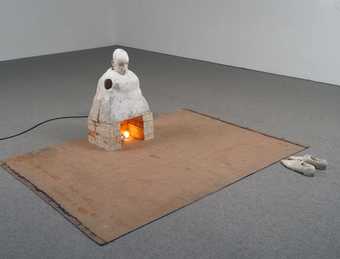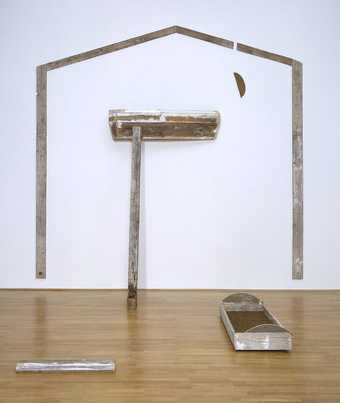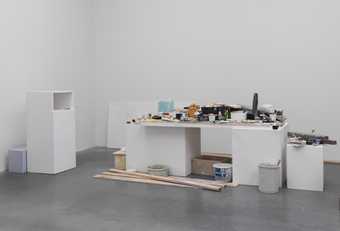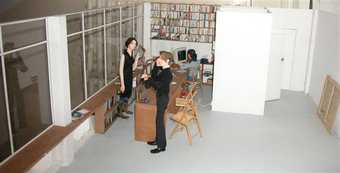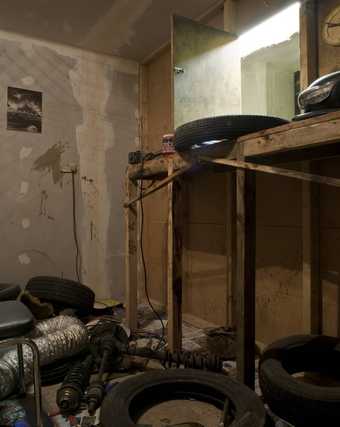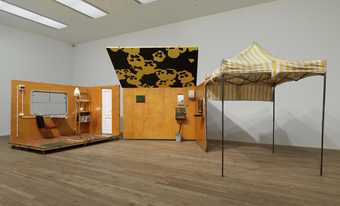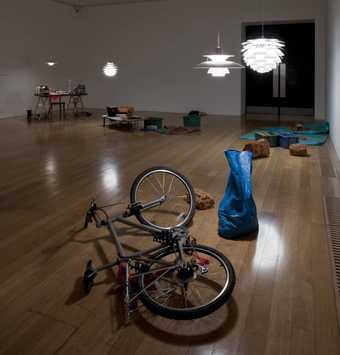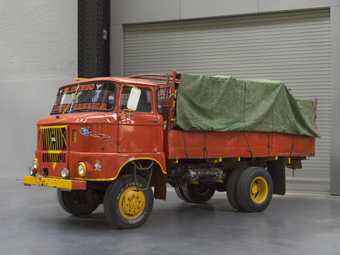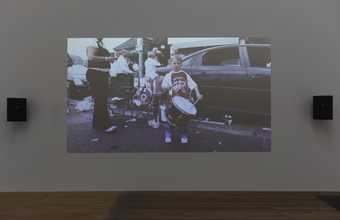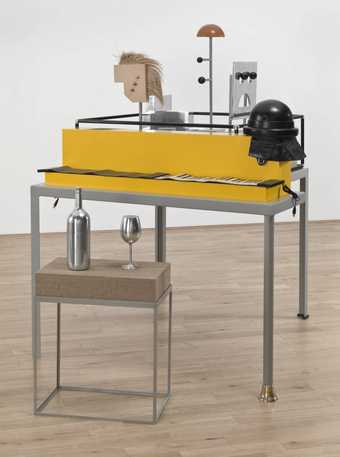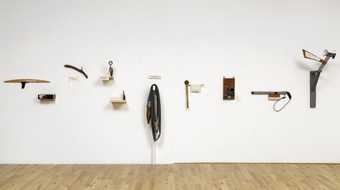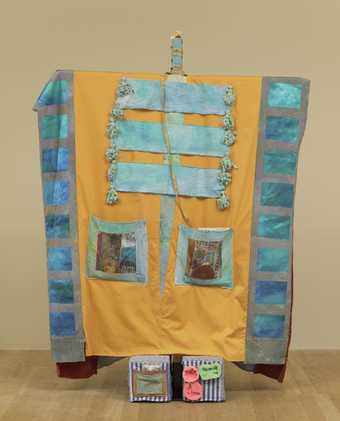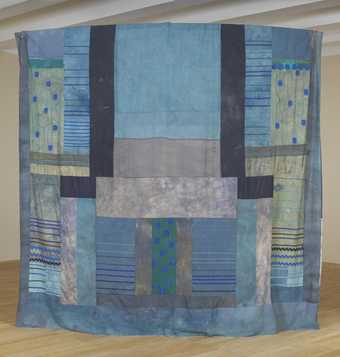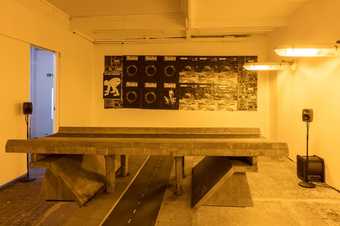
Not on display
- Artist
- Pawel Althamer born 1967
- Original title
- Autoportret jako Biznesmen
- Medium
- Jacket, trousers, dress shirt, silk tie, shoes, socks, underpants, passport, plastic cover, leather briefcase, printed papers and other materials
- Dimensions
- Overall display dimensions variable
- Collection
- Tate
- Acquisition
- Purchased using funds provided by the 2004 Outset / Frieze Art Fair Fund to benefit the Tate Collection 2005
- Reference
- T11913
Summary
Self-Portrait as a Businessman is the result of a commission that took place in Berlin. In collaboration with ART FORUM Berlin, the Sony Centre Advertising Association presented work by five artists from Eastern Europe at the Sony Centre in Potsdamer Platz. Althamer spent the money he was allocated for his commission to buy all the garments he considered to be typical of a businessman, including a suit and white shirt, a briefcase and a mobile phone. At 11pm on 13 September 2002, the day before the show opened, Althamer appeared in the square near the Sony Centre building dressed in his businessman’s outfit and holding the briefcase. He stood in the middle of the square next to the fountain, undressed and walked away naked, leaving his belongings in a heap on the ground. This remained for the duration of the exhibition. The artist considers the pile of clothing and objects to be a sculpture that represents an aspect of himself. As his body is entirely absent, the corporate persona of Pawel Althamer may be read as being a costume which he assumes, or a role that he plays, and from which he may also dissociate himself. When the work is installed, banknotes and coins, including Polish Zloty and Groszy, Swiss Francs and Euros, are scattered on the floor, partially concealed by the crumpled garments. The watch and mobile phone are both in working order, as though abandoned recently. The textiles are predictably anonymous in character – the suit, underpants, socks, belt, lace-up shoes and briefcase are plain black and the shirt is white. Only the tie – red, pale blue and purple silk – and the artist’s Polish passport in a red cover provide a splash of colour and a personal element. When Althamer exhibited the work at Frieze Art Fair, London, in autumn 2004 he added up-to-date Polish newspapers and a Frieze Art Fair flyer in reference to the relations between business and artists highlighted by the art fair.
Self-portraiture and absence have long been central themes in Althamer’s work. A conceptual precursor to Self-Portrait as a Businessman – a self-portrait made in 1994 (Self-Portrait, EVN collection, Maria Enzersdorf, Austria) – comprises the artist’s clothes and such personal items as money, keys, a bus ticket, passport and watch sealed in plastic. Althamer has also created miniature versions of himself (Self-Portrait in a Suitcase 1996, private collection, Switzerland) and employed a stranger to appear as his seventy-year old double (Self-Portrait as an Old Man 2001, an action that took place at the Ludwig Museum, Cologne, during the exhibition I Promise I am Political).
Based in Warsaw, Althamer studied in the Sculpture Department of the Academy of Fine Arts in Warsaw between 1988 and 1993, where he was taught by the sculptor and performance artist Grzegorz Kowalski (born 1942). Althamer was strongly influenced by Kowalski’s focus on process-based and interactive art, becoming one of the group known as Kowalksi’s Workshop or the Kowalnia Smithery, the leading group of young Polish artists of the 1990s. Among the works Althamer submitted for his master’s project at the Academy of Fine Arts in 1993 were a life-sized Self Portrait (collection Marjory Jacobson, Boston, USA), made of grass, hemp fibre, animal intestine, wax and hair, and a film entitled Master’s Project, that shows the artist walking out of the Academy hall, through the city of Warsaw and out into a forest, where he removes his clothes and disappears behind trees.
In 2002, to mark the end of his year-long residency at the DAAD in Berlin, Althamer designed a presentation reflecting his sense of invisibility within the artistic community. Entitled Invisible, the work consisted of posters, printed with paint that slowly disappeared, advertising an action to take place at Alexanderplatz. For the action the artist was absent, or invisible, expressing his sense of alienation within the foreign city. In a parallel event, Althamer held an exhibition in the apartment where he had been living, displaying art made by his wife and children during their year in Berlin, a video showing his work as a refuse collector during that period and a sculptural work, Pawel and Monika 2002 (collection Tom and Daniel Holz, USA), consisting of life-sized sculptures of the artist and his wife, made of grass and animal intestines, holding a video camera and mobile phone in operational condition.
In addition to using himself as the basis for works which involve either crafted objects or such performative actions as being filmed under the influence of a variety of hallucinogenic drugs (LSD, peyote, mescalin, magic mushrooms), Althamer has made many works using people on the fringes of society – the homeless, unemployed, legal and illegal immigrants, prisoners, beggars, street buskers children and teenagers. He has created numerous workshops and expeditions for disadvantaged young people, such as the Einstein Class 2005, a project commissioned to celebrate Einstein’s centenary in Berlin for which Althamer set up physics classes for a group of teenagers who rarely attend school. Other works involve architectural interventions, where Althamer alters the interiors of public spaces in museums and galleries, drawing attention to their histories and local communities. Althamer frequently assumes a quasi-shamanic role, encouraging a sense of the miraculous in the minutiae of everyday life.
Further reading:
Pawel Althamer: The Vincent Van Gogh Bi-Annual Award for Contemporary Art in Europe 2004, exhibition catalogue, Bonnefantenmuseum, Maastricht 2004.
The Impossible Theatre: Performativity in the Works of Pawl Althamer, Tadeusz Kantor, Katarzyna Kozyra, Robert Kusmirowski and Artur Zmijewski, exhibition catalogue, Kunsthalle Wien, Zacheta – National Gallery of Art, Warshau and National Museum Krakau 2005, pp.38-48.
Will Bradley, ‘Social Work’, Frieze, issue 78, October 2003.
Elizabeth Manchester
October 2006
Does this text contain inaccurate information or language that you feel we should improve or change? We would like to hear from you.
Display caption
Althamer explores themes of alienation and isolation, and has made a number of idiosyncratic and unorthodox self- portraits. In this piece, it appears as though the artist has shed his costume in a hurry, but the costume in question – a suit, briefcase and passport – is so anonymous that it represents a form of masquerade, leaving us to wonder where the real Althamer is.
Gallery label, July 2005
Does this text contain inaccurate information or language that you feel we should improve or change? We would like to hear from you.
Technique and condition
The following entry is based on a questionnaire completed by Pawel Althamer received by Tate 28 July, 2005, as well as the conservation record held in Sculpture Conservation.
An installation comprising of bought items of clothing and accessories including a suit, shirt, tie, shoes, underwear, mobile phone, watch, newspapers and money. The items appear to have been casually discarded on the floor by the artist but the layout of this installation is, in fact, not variable. “I arranged them in a certain order and would like (this) order to be kept” (artist questionnaire received by Tate 28 July, 2005). The installation is unique.
Upon acquisition the piece was in good condition with items showing minor signs of natural wear and tear. The artist has specified that he would prefer that their appearance remain that of recently discarded items belonging to a businessman and that they therefore be dusted from time to time when on display.
Jodie Glen-Martin and Bryony Bery
July 2005
Explore
- emotions, concepts and ideas(16,416)
-
- emotions and human qualities(5,345)
- universal concepts(6,387)
-
- artifice(96)
- clothing and personal items(5,879)
- telephone(147)
- named individuals(12,887)
- self-portraits(888)
- dress: fantasy/fancy(506)
- trading and commercial(1,154)
-
- businessman(86)
You might like
-
Miroslaw Balka Fire Place
1986 -
Miroslaw Balka Oasis (C.D.F.)
1989 -
Tomoko Takahashi Drawing Room
1998 -
Peter Fischli, David Weiss Untitled (Tate)
1992–2000 -
Pawel Althamer Foksal Gallery Foundation
2004 -
Mike Nelson The Coral Reef
2000 -
Pawel Althamer, associated with Wilhelm Sasnal, associated with Monika Sosnowska, associated with Jakub Julian Ziolkowski, associated with Artur Zmijewski FGF, Warsaw
2007 -
Simon Starling Work Made-ready, Les Baux de Provence (Mountain Bike)
2001 -
Ernesto Salmeron Auras of War
1996–2006 -
Artur Zmijewski Democracies
2009 -
Steven Claydon Joanna (An Unsubstantial Fraction) (Of Substance Without Action)
2010 -
Jimmie Durham Untitled
1993–2012 -
Tamara Henderson When the wind blows
2016 -
Tamara Henderson Waves, Sleep
2016 -
Mark Leckey Affect Bridge Age Regression
2017–19

